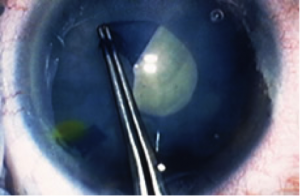Why do I use Trypan Blue in cataract surgery?
Cataracts are a clouding of the lens inside the eye, which are most commonly seen as we get older. This phenomenon can cause blurred vision. It is often noticed by patients who may find it difficult to read or suffer from glare from lights.
Yet, there are patients who do not notice their symptoms, as the cataract can often creep up slowly. This can especially occur if one eye does not suffer from cataract and sees well, effectively masking the worse eye from its symptoms.
I occasionally get patients who have very advanced cataracts. They cope with their symptoms pretty well for a while until it becomes very difficult for them to function normally. A cataract often appears green in colour in the early stages. It further progressing to a brown and then finally becomes a dense white.
I recommend not to leave your cataract too late if you have troublesome symptoms. You can benefit from clearer vision earlier and the cataract surgery can often be easier for your surgeon.
In this blog I wanted to share with you how I tackle difficult cataracts such as dense cataracts that have been left a while. A dense white cataract can present a few challenges to an eye surgeon.
You may recall that one step of cataract surgery is to create a circular opening in the capsular bag that the cataract sits in. This procedure is called continuous curvilinear capsulorrhexis. This step of cataract surgery can be done manually by the eye surgeon. More recently, the surgery can be done with a femtosecond laser in laser cataract surgery.
The creation of a circular opening in the capsular bag by your eye surgeon requires a steady hand and a steady patient. It involves an intrinsic knowledge of the shear and stress forces of a very thin layer of tissue to perform correctly. Usually, the light reflex from the retina helps the eye surgeon to visualize this transparent capsule by creating contrast. This enables the eye surgeon to see the edge of the capsular flap. That has been created and enables them to grasp and tear correctly. Once finished, a circular opening of about 5.5 millimeters in diameter remains. That is the correct size to hold the new intra-ocular lens implant in the capsular bag. One of the difficulties of the capsulorrhexis step is that the capsule has a tendency to tear out. Furthermore, the surgeon requires the skill to maintain a circular shape at all times. If the capsular bag tears out, there is a chance the cataract could be displaced into the vitreous cavity at the back of the eye. There it cannot be retrieved without a further more complex operation.
One of the challenges of a operating on a white cataract is that visualizing the capsule can be very difficult. There is no light reflex from the retina to help and there is no contrast. Moreover, the tensile strength of the capsular bag can be altered by the density of the cataract.
So how do we visualize the capsule in the situation of a dense cataract to perform capsulorrhexis?
 Well, thankfully an injectable blue dye known as Trypan blue can be used to stain the capsule. This pathology stain was adapted for use in the eye where eye surgeons needed better visualization of the capsule.
Well, thankfully an injectable blue dye known as Trypan blue can be used to stain the capsule. This pathology stain was adapted for use in the eye where eye surgeons needed better visualization of the capsule.
Once the Trypan blue has been injected inside the eye and it stains the capsule, the circular capsule opening can be performed safely. It can be applied the same technique as usual. The Trypan blue is safe and does not cause any permanent staining of other eye structures.
Having Trypan blue is a useful additional aide to performing complex cataract surgery. I have used it successfully in hundreds of patients with dense cataracts. Its use has undoubtedly helped ensure the continued success of cataract surgery in patients with dense cataracts. More importantly, it is often this group of patients who are most overwhelmed by the impact of clear vision after their cataract surgery.
If you have cataracts and would like an opinion on whether cataract surgery could improve your vision, please feel free to call me on 07919 895 448 and we can discuss your specific needs.


![Five Facts about Toric Intra-ocular Lenses [Infographic]](https://jaheedkhan.co.uk/wp-content/uploads/2016/12/jk-toric-lenses-500x383.jpg)
